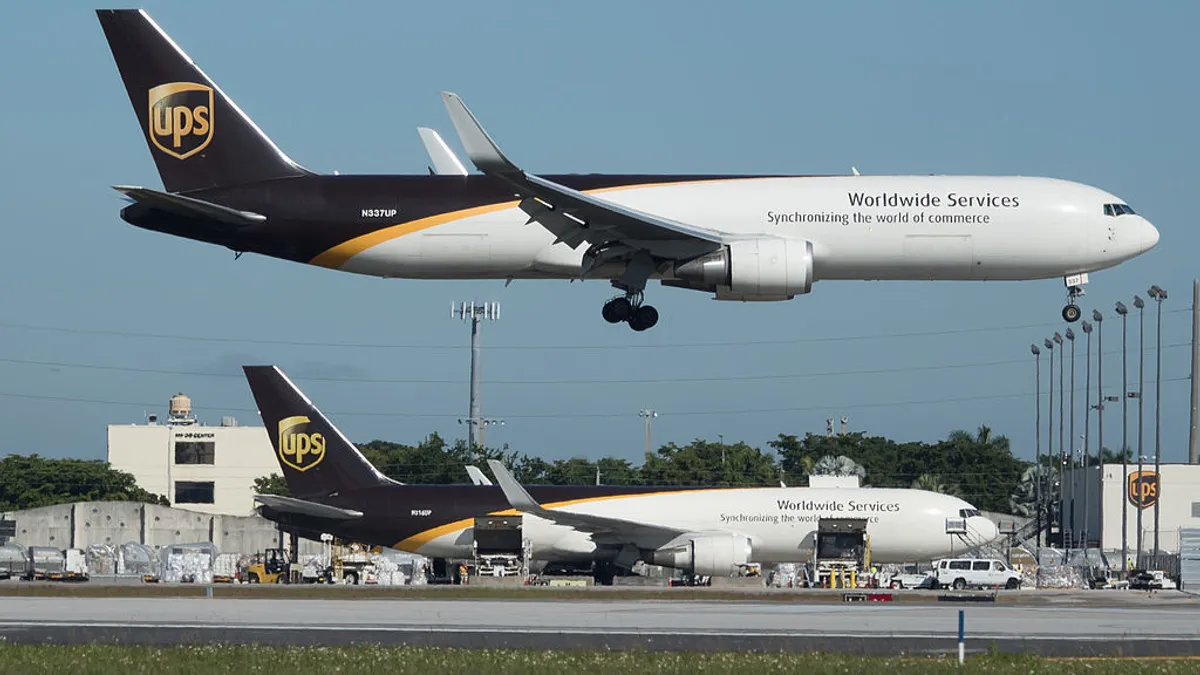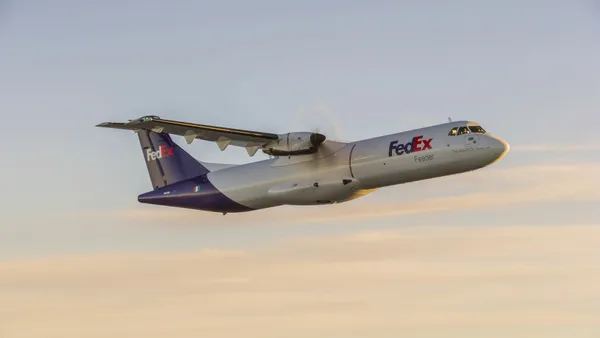Dive Brief:
- Airfreight rates from China and Hong Kong to the U.S. have fallen nearly 50% from their peak in mid-May to reach $5.1 per kilogram on June 15, according to the latest numbers from the TAC Index.
- Exports from Hong Kong International Airport grew more than 1% in May after being down year over year in April (-7.5%) and March (-8.7%), according to a research note from UBS.
- Spot prices were up 109% year over year in May. While rates are beginning to fall they're still fairly lofty: up 65% year over year through June 8, according to UBS.
Dive Insight:
The coronavirus pandemic has roiled the air cargo market by reducing demand for passenger travel while increasing the demand to quickly ship essential items including personal protective equipment (PPE).
"PPE is a product that normally goes on ocean," Global Head of Airfreight at Flexport Neel Jones Shah told Supply Chain Dive in an interview. "And all of the sudden there was a demand for millions and millions of cubic feet of PPE to be shipped from China to the U.S."
Shah said the demand "caught everyone a little off guard. ... That led to what was the fastest rising airfreight rates I have ever seen" as shippers bid for scarce capacity.
Shippers dealt with the sticker shock by either canceling shipments, absorbing it in their margins or passing it along to their customers, he said.
Passenger airlines have slashed capacity since there is little interest in consumer travel. Delta Air Lines temporarily parked more than 700 aircraft across its system, which includes every aircraft type it operates, Delta CEO Ed Bastian said at the company's annual shareholder meeting last week. Delta announced Monday it will gradually restart passenger service between Seattle and Shanghai June 25.
The demand for cargo has been one of the few bright spots for passenger airlines. United Airlines expects its second-quarter revenue to be down about 88%, but the airline is forecasting its cargo revenue to be up about 30% year over year in the second quarter, according to a slide deck from an investor presentation the company gave earlier this month.
Demand for shipping PPE via air has largely fallen, which is an important factor in the falling rates, Maayan Citron, the head of corporate marketing at Freightos, told Supply Chain Dive in an email, adding, "most areas have been able to build up inventories of PPE, and can now use ocean to ship parts of the ongoing demand."
Consumer demand is also down as economies across the world struggle amid continued lockdowns and job losses. "So traditional airfreight products — there's less demand for those," Shah said.
Freight flights by passenger airlines, dubbed "preighter" flights, will likely become less frequent throughout the summer, though, as the cost of fuel is rising and making the trips less profitable for airlines. Capacity is expected to remain an issue even as freighters are flying more hours and is why rates are still well above where they were the same time a year ago, Shah said.
"A lot of carriers are opting to pull these flights out of particularly the Trans-Pac," he said.
The federal government has provided guidance to passenger airlines for carrying cargo in cabins, including passenger seats.
"Converted passenger jets contributed to easing some of the capacity crunch during the peak of the crisis, and as those are being phased out it is possible capacity will remain tight as some of the PPE demand is replaced with commercial cargo," Citron said.
And as airfreight rates decline, ocean carriers continue to pull capacity, pushing ocean rates up.
"We are in a situation where there could be the opportunity to even see some ocean to air conversion," Shah said, adding that the peak in ocean rates could last for "several weeks" but it will depend on consumer demand and any potential second lockdowns.














